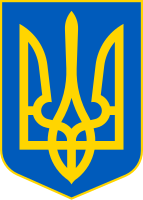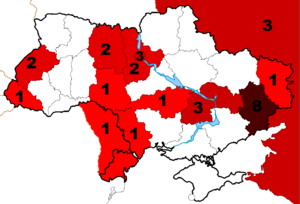First Azarov government facts for kids
Quick facts for kids First Azarov Government |
|
|---|---|
| 14th Cabinet of Ukraine (since 1990) | |
 |
|
| Date formed | March 11, 2010 |
| Date dissolved | December 3, 2012 |
| People and organisations | |
| Head of state | Viktor Yanukovych |
| Head of government | Mykola Azarov |
| Deputy head of government | Valeriy Khoroshkovskyi |
| No. of ministers | 18 |
| Member party | Party of Regions Communist Party of Ukraine Lytvyn Bloc |
| Status in legislature | Coalition "Stability and reforms" |
| Opposition cabinet | Dictatorship Resistance Committee |
| Opposition party | Yulia Tymoshenko Bloc NUNS |
| Opposition leader | Serhiy Sobolev (head of shadow government) |
| History | |
| Legislature term(s) | 5 years |
| Predecessor | Second Tymoshenko government |
| Successor | Second Azarov government |
The first Azarov government (Ukrainian: Перший уряд Миколи Азарова) was the group of top government officials, or cabinet, in Ukraine. It was in power from March 11, 2010, until December 3, 2012. After this date, it acted as a temporary, or caretaker government, until a new government was officially appointed on December 24, 2012.
This government was formed by a group of political parties working together in the Verkhovna Rada, which is Ukraine's parliament. These parties were the Party of Regions, Lytvyn Bloc, and the Communist Party of Ukraine. The government was led by Prime Minister Mykola Azarov. He took over after the previous government, led by Yulia Tymoshenko, was removed. The Azarov government worked closely with the President of Ukraine at the time, Viktor Yanukovych.
A survey in November 2010 showed that not many people fully supported the Azarov Government. Only about 13% of people surveyed said they fully supported it, while 45% said they did not. The government's members were changed around by President Yanukovych in early 2012.
Contents
How the Government Ended
On December 3, 2012, the first Azarov government officially resigned. This happened after the parliamentary election on October 28, 2012. President Viktor Yanukovich accepted the resignation of Prime Minister Mykola Azarov and his team. Many members of the government, including Prime Minister Azarov himself, were elected to parliament in that election. To become members of parliament, they had to leave their government jobs.
A few days later, on December 9, 2012, President Yanukovych asked Mykola Azarov to be Prime Minister again. Parliament agreed to this on December 13, 2012. Then, on December 24, 2012, the second Azarov government officially started its work. In January 2013, President Yanukovych said that the government "had not fully completed its tasks" for making reforms and helping the economy grow. He noted that the results in 2012 were "much worse than expected."
Opposition Government
When the Azarov government was in power, several other political parties formed an "opposition government." This is sometimes called a shadow government. It's like a government-in-waiting, where opposition parties prepare their own plans and leaders. They show how they would govern if they were in charge.
On March 16, 2010, eight opposition parties signed an agreement to create this opposing group. These parties included All-Ukrainian Union "Fatherland", Rukh, and the European Party of Ukraine. On March 31, 2010, they announced the members of their shadow government. It was led by Serhiy Sobolev from the Yulia Tymoshenko Bloc.
Later, on August 8, 2011, some of these parties, along with others like Civil Position and Front for Change, formed the Dictatorship Resistance Committee. This group aimed to work together better to oppose the ruling government.
Who Was in the Government?
On March 11, 2010, the Verkhovna Rada (Ukraine's parliament) approved the structure of the Cabinet of Ministers. When it first started, the cabinet had 29 ministers. This was four more than the government before it. It also had a high number of "vice premiers" (deputy prime ministers). Interestingly, 8 out of the first 29 cabinet members were born in the Donetsk Oblast region.
At first, this government was the only one in Europe that did not have any women ministers. However, this changed on February 14, 2012, when Raisa Bohatyriova was appointed as Minister of Healthcare and a Vice Prime Minister.
Over time, the number of ministers was reduced as part of government reforms. For example, in December 2010, the number of ministries was cut from 20 to 16. This was done to make the government smaller and more efficient. There were also several changes in who held which ministerial positions throughout the government's time in power.
What Were Their Goals?
The first Azarov government had several main goals for Ukraine:
- Reduce the gap between rich and poor: They wanted to make sure everyone had a fairer chance. This included plans to raise the minimum wage and increase pensions and social benefits.
- Improve living standards: They aimed to make life better for all Ukrainians. This involved creating a "state anti-crisis food basket" and a "state anti-crisis medical basket" to help with basic needs. They also wanted to keep prices stable for everyday goods and energy.
- Introduce European social protection standards: They planned to reform how social support and benefits were given out. They also wanted to improve support for children and address the falling birth rate.
- Fight corruption: The government aimed to reduce corruption. They planned to make government processes more transparent, especially for business registrations, state purchases, and land allocation.
- Boost economic growth: They wanted the economy to grow, focusing on new technologies. They also aimed to improve the financial health of state-owned companies.
- Reform housing and utilities: This included providing affordable housing and building social housing for young people, public workers, and families in need.
- Strengthen the middle class: They wanted to help more people join the middle class.
- Protect citizens' rights: Ensuring that people's rights and freedoms were protected both inside and outside Ukraine.
Other important tasks for the government included preparing for floods, supporting agricultural work in spring, and improving medical services. They also planned to sell off some state-owned companies to increase government income.
In March 2010, the parliament delayed new laws on the justice system and anti-corruption measures. In November 2010, President Yanukovych rejected a new tax code that had caused large protests across Ukraine. He signed a different version of the tax code in December 2010. Some economic experts later said that the Azarov government's economic policies had weakened Ukraine's finances.
Government Changes and Reforms
On December 9, 2010, President Yanukovych announced a major government reorganization. This was part of an "administrative reform" to make the government smaller and more effective. The number of ministries was reduced from 20 to 16, and the number of government employees was cut by more than half.
This reform involved merging some ministries and changing the responsibilities of others. For example, the Ministry of Economy became the Ministry of Economic Development and Trade. The Ministry of Transportation and Communications became the Ministry of Infrastructure. The goal was to streamline government operations and reduce bureaucracy.


